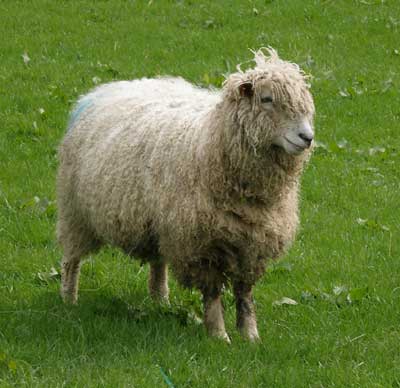The Cotswold region has been greatly influenced by its association with its sheep. Medieval wool towns thrived, wealthy wool merchants built grand houses and also beautiful 'wool' churches, complete with memorial brasses depicting the merchants and hinting at the source of their substantial wealth, their great sheep.
The sheep, in turn, have been influenced by the hills on which they live. Archaeological evidence, including skeletal remains of very large polled sheep and identification of fibres from white-fleeced sheep not present in the preceding Iron Age, indicates that their ancestors were introduced by the Romans as they battled northwards. They were certainly bigger and heavier-boned than the little Celtic sheep and did not shed their considerably longer wool. The recent discovery near Cambridge of Roman pipeclay figures of sheep with a curly fleece, sturdy body and the general appearance of a recently-shorn, modern longwool is further supporting evidence for the existence in Roman Britain of a new type of sheep, from which the primitive longwool would seem to have emerged in regions where Roman sheep-farming flourished. By the 13th and 14th centuries the sheep had adapted to the hills on which they had then developed for over a thousand years. Limestone grows good bone so they could be large, the permanent pastures were rich in herbs and grasses that ensured a reasonable food supply throughout the year and the bare aspect favoured a breed with a heavy fleece. Flock-masters selected for quality fleece as the market for wool became synonymous with wealth.
One of the first literary descriptions of the Cotswold appeared 400 years ago in Michael Drayton's Polyolbion and by 1546 the sheep were already known as 'Cotswold Lions', a popular name which still persists, which would indicate that in some respects they must have looked very much like the Cotswold of modern times.
During the 19th century the Cotswold reached its second golden age, this time as meat producer. In the 18th century the population of Britain had begun to increase rapidly and there had been fast-growing demand for agricultural products, emphasis being on the production of meat rather than wool. Cotswold rams were in great demand, resulting in brisk trade and high prices. It was not unusual for 5000 rams to be sold or hired in a season in Gloucestershire, achieving prices as high as 230 guineas (£241.50) in 1864.
The rams were widely used on other breeds and experiments crossing Cotswold rams with Hampshire and Southdown ewes resulted in the Oxford Down, initially called the Down Cotswold. Breeders also enjoyed a good export trade to America, Canada, Germany, France, Austria, Russia, Australia and New Zealand. In Europe the Cotswold was used on the North German Marsh sheep to produce the Oldenburg.
There was another reason for the popularity of the Cotswold ram. The Cotswold and its cross progeny were alleged to have been free from scrapie. In scrapie disease in sheep (1983), H.B.Parry described the devastating effects of this incurable progressive disease on the sheep industry of Britain during the late 18th century and onwards. By the middle of the 19th century scrapie appears no longer to have been of such serious concern in southern England and Parry associated this with the widespread use of breeds such as the Cotswold.
At the beginning of the 20th century changes in agriculture and in demand for meat and wool contributed to the breed's gradual decline. In the 1960s, with export orders still coming in for Cotswolds to be sent to the Shah of Iran and also to China and Turkey, positive action was taken to conserve the breed.
Today there is a clear revival of interest in the Cotswold, which can be attributed to its very definite appeal as an ancient breed that has stood the test of time and to the fact that the breed has many traditional qualities that can suit the current market.
